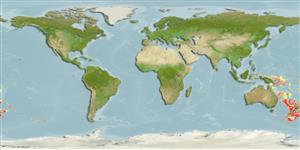Common names from other countries
Holocephali (helhuvudsfiskar) (chimaeras) >
Chimaeriformes (Chimaeras) >
Chimaeridae (Shortnose chimaeras or ratfishes)
Etymology: Hydrolagus: hydro-, combining form of hydor (Gr.), water; lagos (Gr.), hare, i.e., “water rabbit,” probably referring to three pairs of tooth plates, which tend to protrude from the mouth like a rabbit’s incisors. (See ETYFish); trolli: In honor of American artist Ray Troll (b. 1954), Ketchikan, Alaska (USA), “one of the few true chimaeroid lovers of the world ... for his valiant efforts to increase ratfish awareness worldwide”. (See ETYFish).
Environment: milieu / climate zone / depth range / distribution range
Ekologi
marina djupbottenlevande; djupintervall 612 - 1707 m (Ref. 45071). Deep-water
Western Pacific: New Caledonia and New Zealand.
Size / Vikt / Age
Maturity: Lm ? range ? - ? cm
Max length : 112 cm TL hane/ej könsbestämd; (Ref. 45071); 120.4 cm TL (female); publicerad maxvikt: 8.8 kg (Ref. 122636)
Short description
Bestämningsnycklar | Morfologi | Morfometri
Body blue-gray with a dark line around the orbit and dark shadowing along edges of lateral-line canals. Snout pointed. Preopercular and oral lateral-line canals sharing a common branch. D1 concave with pale margin. Males with frontal tenaculum deeply curved, upturned distally with spines along dorsal upturned edge. Prepelvic tenacula deeply indented along distal margin. Pelvic claspers with pale fleshy distal lobes, divided distally for 1/3 their length, tips usually extending beyond distal edge of pelvic fins. Ventral caudal fin not deeply indented at its origin to form a separate anal fin.
Oviparous (Ref. 205). Eggs are encased in horny shells (Ref. 205). Reported sexual maturity at 550-65.0 cm BDL or body length (Ref. 116866).
Life cycle and mating behavior
Maturities | Reproduktion | Spawnings | Egg(s) | Fecundities | Larver
Didier, D.A. and B. Séret, 2002. Chimaeroid fishes of New Caledonia with description of a new species of Hydrolagus (Chondrichthyes, Holocephali). Cybium 26(3):225-233. (Ref. 45071)
IUCN Red List Status (Ref. 130435)
CITES (Ref. 128078)
Not Evaluated
Threat to humans
Harmless
Human uses
Verktyg
Special reports
Download XML
Internet-källor
Estimates based on models
Preferred temperature (Ref.
115969): 3.4 - 6.9, mean 4.8 (based on 322 cells).
Phylogenetic diversity index (Ref.
82804): PD
50 = 0.5000 [Uniqueness, from 0.5 = low to 2.0 = high].
Bayesian length-weight: a=0.00282 (0.00118 - 0.00673), b=3.10 (2.89 - 3.31), in cm Total Length, based on LWR estimates for this (Sub)family-body shape (Ref.
93245).
Trofisk nivå (Ref.
69278): 4.0 ±0.6 se; based on size and trophs of closest relatives
Resiliens (Ref.
120179): Låg, lägsta populationsfördubblingstid 4,5-14 år (Assuming Fec <100).
Fishing Vulnerability (Ref.
59153): High to very high vulnerability (72 of 100).
